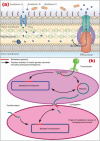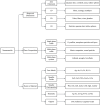Unleashing the promise of emerging nanomaterials as a sustainable platform to mitigate antimicrobial resistance
- PMID: 38694553
- PMCID: PMC11062400
- DOI: 10.1039/d3ra05816f
Unleashing the promise of emerging nanomaterials as a sustainable platform to mitigate antimicrobial resistance
Abstract
The emergence and spread of antibiotic-resistant (AR) bacterial strains and biofilm-associated diseases have heightened concerns about exploring alternative bactericidal methods. The WHO estimates that at least 700 000 deaths yearly are attributable to antimicrobial resistance, and that number could increase to 10 million annual deaths by 2050 if appropriate measures are not taken. Therefore, the increasing threat of AR bacteria and biofilm-related infections has created an urgent demand for scientific research to identify novel antimicrobial therapies. Nanomaterials (NMs) have emerged as a promising alternative due to their unique physicochemical properties, and ongoing research holds great promise for developing effective NMs-based treatments for bacterial and viral infections. This review aims to provide an in-depth analysis of NMs based mechanisms combat bacterial infections, particularly those caused by acquired antibiotic resistance. Furthermore, this review examines NMs design features and attributes that can be optimized to enhance their efficacy as antimicrobial agents. In addition, plant-based NMs have emerged as promising alternatives to traditional antibiotics for treating multidrug-resistant bacterial infections due to their reduced toxicity compared to other NMs. The potential of plant mediated NMs for preventing AR is also discussed. Overall, this review emphasizes the importance of understanding the properties and mechanisms of NMs for the development of effective strategies against antibiotic-resistant bacteria.
This journal is © The Royal Society of Chemistry.
Conflict of interest statement
We confirm that there are no known conflicts of interest associated with this work, and there has been no significant financial support for this work that could have influenced its outcome. Furthermore, we ensure that the manuscript has been read and approved by all named authors and that there are no other persons who satisfied the criteria for authorship but are not listed. We further confirm that we have all approved the authors' order listed in the manuscript. Due care has been taken to ensure the integrity of the work.
Figures
















Similar articles
-
Recent Advances in Nanotechnology-Aided Materials in Combating Microbial Resistance and Functioning as Antibiotics Substitutes.Int J Nanomedicine. 2020 Oct 2;15:7329-7358. doi: 10.2147/IJN.S265934. eCollection 2020. Int J Nanomedicine. 2020. PMID: 33116477 Free PMC article. Review.
-
Exploring bio-nanomaterials as antibiotic allies to combat antimicrobial resistance.Biofabrication. 2024 Aug 29;16(4). doi: 10.1088/1758-5090/ad6b45. Biofabrication. 2024. PMID: 39102846 Review.
-
Emerging trends and future challenges of advanced 2D nanomaterials for combating bacterial resistance.Bioact Mater. 2024 May 7;38:225-257. doi: 10.1016/j.bioactmat.2024.04.033. eCollection 2024 Aug. Bioact Mater. 2024. PMID: 38745587 Free PMC article. Review.
-
A hope for ineffective antibiotics to return to treatment: investigating the anti-biofilm potential of melittin alone and in combination with penicillin and oxacillin against multidrug resistant-MRSA and -VRSA.Front Microbiol. 2024 Feb 1;14:1269392. doi: 10.3389/fmicb.2023.1269392. eCollection 2023. Front Microbiol. 2024. PMID: 38370578 Free PMC article.
-
Thymol-Decorated Gold Nanoparticles for Curing Clinical Infections Caused by Bacteria Resistant to Last-Resort Antibiotics.mSphere. 2023 Jun 22;8(3):e0054922. doi: 10.1128/msphere.00549-22. Epub 2023 Apr 5. mSphere. 2023. PMID: 37017551 Free PMC article.
Cited by
-
In vitro evaluation of silver-zinc oxide-eugenol nanocomposite for enhanced antimicrobial and wound healing applications in diabetic conditions.Discov Nano. 2025 Jan 23;20(1):14. doi: 10.1186/s11671-025-04183-0. Discov Nano. 2025. PMID: 39847138 Free PMC article.
-
Evaluation of the Antibacterial and Anti-Biofilm Activity of Chitosan-Arginine Nanoparticles and Sodium Fluoride against Streptococcus mutans.Int J Mol Cell Med. 2025 Jul 1;14(2):637-645. doi: 10.22088/IJMCM.BUMS.14.2.637. eCollection 2025. Int J Mol Cell Med. 2025. PMID: 40765761 Free PMC article.
References
-
- Buzea C. and Pacheco I., “Nanomaterial and Nanoparticle: Origin and Activity,” Nanoscience and Plant–Soil Systems, Springer International Publishing, 2017, pp. 71–112, 10.1007/978-3-319-46835-8_3 - DOI
Publication types
LinkOut - more resources
Full Text Sources
Research Materials

